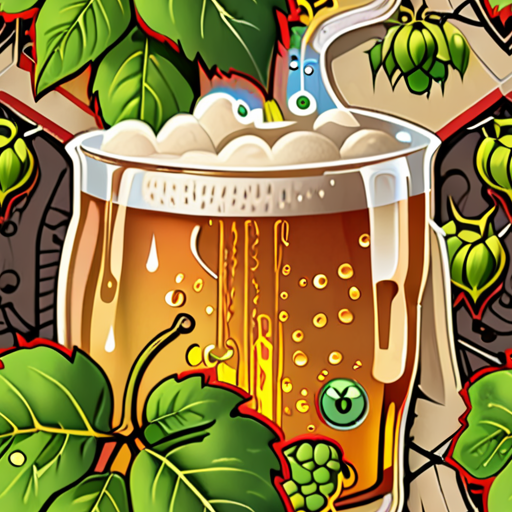The beer industry has long been plagued by issues related to quality control, consistency, and consumer perception. One of the primary challenges facing breweries today is finding effective solutions to these problems through innovative approaches to beer production, packaging, and distribution. By understanding the science behind beer foam formation and implementing temperature control systems, breweries can improve their products and customer experiences. Additionally, addressing concerns about beer’s image and perception requires a multifaceted approach that includes rebranding efforts, marketing campaigns, and highlighting the cultural significance and heritage of beer.

The 3:30300 Rule for Beer
When it comes to storing beer, freshness matters, and understanding the 3:30300 rule can help you enjoy your favorite brews at their best.
- Understanding the Rule: The 3:30300 rule states that beers stored for 3 days at 90°F, 30 days at 72°F, or 300 days at 38°F will see the same level of oxidation that can affect the flavor and aroma of your beer.
- Factors Affecting Oxidation: Temperature, storage conditions, and packaging play significant roles in determining how quickly beer oxidizes. Proper storage and handling can minimize oxidation and preserve the beer’s flavor and aroma.
- Importance of Freshness: Freshness is crucial for beer, as it affects the overall taste, smell, and mouthfeel. Storing beer under optimal conditions helps preserve its character and ensures a better drinking experience.
- Best Practices for Beer Storage: To keep your beer fresh, store it in a cool, dark place, away from direct sunlight and heat sources. Keep the bottles or cans upright to prevent sediment from settling, and consider investing in a beer fridge or cooler for optimal storage conditions.
- Beer Styles and Shelf Life: Different beer styles have varying shelf lives due to factors like ABV, hop content, and yeast strain. Generally, lighter-colored beers tend to last longer than darker ones, but always check the packaging for specific storage recommendations.
- Monitoring Beer Quality: Regularly inspect your beer for signs of spoilage, such as off-flavors, skunkiness, or mold growth. If you notice any issues, it’s best to err on the side of caution and discard the beer to avoid contamination and potential health risks.
By following the 3:30300 rule and adopting best practices for beer storage, you can enjoy your favorite brews at their best and appreciate the nuances of different beer styles.
Four Common Problems with Beer
Breweries strive to produce high-quality beers, but sometimes issues can arise during the brewing process.
- Bacterial Spoilage
- Ingredient Variation
- Haze
- Improper Carbonation Level
This is perhaps the most feared problem in beer production, especially for non-pasteurizing breweries. Bacterial contamination can occur due to poor sanitation, inadequate equipment cleaning, or contaminated ingredients.
Ingredients play a crucial role in determining the flavor and quality of beer. Variations in ingredient quality, quantity, or type can affect the final product’s taste, aroma, and overall character.
Haze in beer can be caused by several factors, including poor filtration, incorrect storage conditions, or the presence of particles. Haze can negatively impact the appearance and overall drinking experience of beer.
Carbonation is essential for beer’s refreshing quality and mouthfeel. However, improper carbonation levels can result in flat or over-carbonated beers, affecting the drinker’s enjoyment.
At The Goods On Tap , we understand the importance of producing high-quality beers. Our team of experts is committed to helping breweries overcome these common problems and deliver exceptional beers to our customers.
We recommend checking out our brewery reviews section for in-depth analysis of various breweries and their products. Additionally, our beer trends page provides valuable insights into the latest developments in the craft beer industry.
For more information on beer production and quality control, visit the Brewers Association website, which offers a wealth of knowledge and resources for brewers and beer enthusiasts alike.

What is Beer Method?
The beer method, also known as the brewing process, is a multi-step procedure involved in producing beer.
- Malted grains are crushed and mixed with hot water to create a sugary liquid called wort.
- The wort is then boiled with hops, which adds bitterness, flavor, and aroma to the beer.
- After boiling, the wort is cooled and transferred to a fermentation tank where yeast is added to convert the sugars into alcohol and carbon dioxide.
- The beer is left to ferment for several days or weeks, depending on the type of beer being produced.
- Once fermentation is complete, the beer is transferred to a conditioning tank where it is allowed to mature and develop its flavors.
- Finally, the beer is packaged and distributed to stores and bars for consumption.
This process can vary slightly depending on the type of beer being produced, but these basic steps remain the same.
Key Steps in the Beer Method:
- Malting and Milling
- Mashing and Extract Separation
- Hop Addition and Boiling
- Cooling and Aeration
- Fermentation
- Conditioning
- Carbonation
- Packaging
Each step plays a crucial role in the production of high-quality beer, and brewers must carefully monitor and control each stage to ensure the final product meets their standards.
Importance of Quality Control:
Quality control is essential in the beer method to ensure that the final product meets the brewer’s standards and is safe for consumption.
- Brewers must regularly test the beer for pH levels, temperature, and other factors to ensure it is within acceptable ranges.
- They must also monitor the fermentation process to prevent contamination and ensure that the yeast is healthy and active.
- Regular cleaning and sanitizing of equipment is also critical to preventing contamination and spoilage.
By controlling every aspect of the beer method, brewers can produce high-quality beer that meets the demands of discerning consumers.

The Biggest Problem Facing the Beer Industry
Navigating challenges is a significant issue for the craft beer industry, with rising costs of ingredients, packaging materials, and labor putting pressure on the profitability of craft breweries.
- Rising costs of ingredients, such as hops and barley, can impact production costs and ultimately retail prices.
- Fluctuations in commodity prices can lead to supply chain issues, affecting the availability of raw materials and impacting production schedules.
- Labor costs continue to rise, making it challenging for breweries to maintain profitability while meeting increasing demand.
- Increased competition from larger breweries and changing consumer preferences are forcing smaller breweries to adapt and innovate to remain competitive.
The craft beer industry is facing numerous challenges, including:
- Cost Pressures: Rising ingredient costs, labor expenses, and packaging material costs are squeezing profit margins for craft breweries.
- Supply Chain Issues: Fluctuating commodity prices and supply chain disruptions can impact the availability of raw materials, leading to production delays and increased costs.
- Changing Consumer Preferences: Shifting consumer tastes and preferences are forcing breweries to innovate and adapt their product offerings to stay competitive.
- Increased Competition: Growing competition from larger breweries and changing market dynamics are making it increasingly difficult for smaller breweries to stand out and attract customers.
To navigate these challenges, craft breweries must focus on:
- Efficient Operations: Streamlining processes, reducing waste, and optimizing production schedules can help breweries minimize costs and maximize efficiency.
- Innovative Product Development: Creating unique and appealing products can help breweries differentiate themselves and attract price-sensitive consumers.
- Diversified Revenue Streams: Exploring alternative revenue streams, such as taproom sales, merchandise, and events, can help breweries reduce dependence on traditional sales channels.
- Strategic Partnerships: Collaborating with suppliers, distributors, and other breweries can help breweries access new markets, share knowledge, and mitigate risks.
By addressing these challenges and adopting innovative strategies, craft breweries can position themselves for long-term success and continued growth in the rapidly evolving beer industry.
Why Is Beer Losing Popularity?
The decline of draft beer consumption at bars can be attributed to several factors.
- Americans increasingly prefer socializing at home, opting for convenience and comfort over traditional bar experiences.
- The beer industry has shifted its sales priorities, focusing on packaged goods and away from draft beer.
- Cocktails and spirits have gained immense popularity, drawing consumers away from beer.
- Rising costs associated with going out to bars, including increased prices for drinks and food, contribute to the decline.
In recent years, the craft beer industry has experienced significant growth, with many breweries expanding their operations and offerings.
- The rise of craft beer has led to increased competition for traditional bars and pubs, making it challenging for them to remain competitive.
- Changing consumer preferences, including a growing interest in low- and no-alcohol beverages, further impact the beer market.
- The COVID-19 pandemic accelerated the shift towards at-home entertainment, exacerbating the decline of draft beer consumption at bars.
As the beer landscape continues to evolve, it is essential for bars and breweries to adapt and innovate to stay relevant and attract customers.
- Offering unique experiences, such as live music and events, can help draw in crowds and differentiate establishments from others.
- Investing in digital marketing and social media can aid in reaching a wider audience and promoting offerings effectively.
- Focusing on quality and consistency in products and services can help build loyalty among customers and drive repeat business.
By understanding the underlying factors contributing to the decline of draft beer consumption and implementing effective strategies, bars and breweries can work towards revitalizing their businesses and attracting customers in a rapidly changing market.

The Biggest Alcohol Problem
Alcohol consumption has numerous negative impacts on health, leading to various medical complications.
- Cardiovascular System Damage
- Mental Health Concerns
- Cancer Risks
- Digestive Issues
Heavy alcohol use causes approximately 9,000 deaths per year due to heart disease and stroke, and even moderate drinking is associated with an increased risk for hypertension, arrhythmias, heart attack, and stroke.
Excessive drinking can lead to depression, anxiety disorders, and suicidal thoughts, affecting millions of people worldwide.
Consuming large amounts of alcohol increases the likelihood of developing certain types of cancer, including liver, breast, colon, and esophageal cancers.
Drinking excessively can cause damage to the digestive system, resulting in conditions such as pancreatitis, gastritis, and ulcers.
Addressing the Issue
To mitigate these problems, individuals should be aware of their drinking habits and take steps to reduce their consumption.
- Set Limits
- Prioritize Health
- Seek Support
Establish a daily limit for yourself and stick to it to minimize the risks associated with excessive drinking.
Focusing on overall well-being through regular exercise, balanced diet, and sufficient sleep can help counteract the negative effects of alcohol.
If struggling with addiction or experiencing related mental health issues, consider seeking professional help from a healthcare provider or support group.
Conclusion
By acknowledging the severity of alcohol-related problems and taking proactive measures to address them, we can work towards reducing the devastating consequences of excessive drinking and promoting healthier lifestyles.

0 Comments